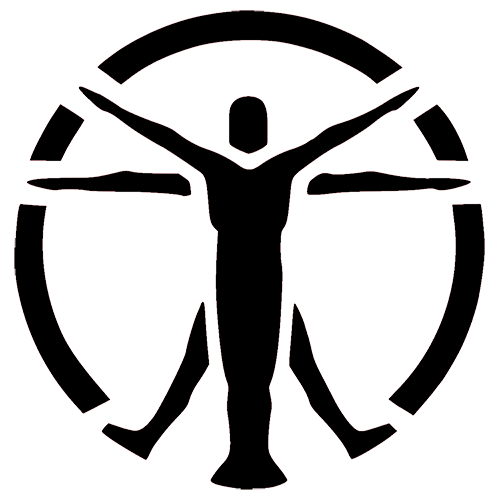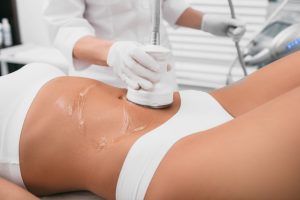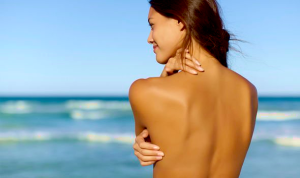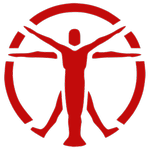Acne is not only a problem for teenagers, but it is also often a problem for adults as well. The average age of people with acne has increased in the last decade from 20.5 to 26.5 years. It is the most common skin problem. 85% of people have experienced some form of acne at some point in their lives. Up to 50 million Americans have some form of acne, and 15% of them have severe acne that forms scarring on the skin [1].
Acne causes a lot of people serious emotional distress, and they look for different ways to get rid of the problem. Some methods are more effective, some less effective, and some don’t work at all.
The main treatment options for acne used to be various oral and topical methods. But patients for the most part either do not have a response to them or suffer from side effects.
Scientists have begun to investigate safe, side-effect-free methods of treating acne. One such method is a non-invasive procedure – light therapy. In this article, we present the results of the analysis of clinical studies on the effectiveness of this method.
Scientists About the Effects of Light Therapy on the Skin
Red light therapy (RTL), also known as photobiomodulation (PBM) or red low-level laser therapy (LLLT), is a non-invasive treatment that uses red and near-infrared light. Light in this wavelength range penetrates deeper into the skin than other light sources in the spectrum, thereby affecting the body at the cellular level.
Red light therapy (RLT) limits the inflammatory response and reduces oxidative damage by reducing the number of inflammatory cytokines [2]. Therefore, red light therapy is actively used in the treatment of inflammatory diseases such as psoriasis, rosacea, acne, and others. Red light combined with blue light (which has a proven antimicrobial effect) increases the effectiveness of acne treatment [3]. Also, the use of LED-RL phototherapy in the early postoperative period can optimize wound healing and prevent excessive scarring [4].
Scientists do not yet have a definitive answer as to why improvements occur, and more research is still being done to find out. But many clinical studies are showing the effects of light therapy on acne and post-acne. Below we look at some of them.

Clinical Studies on the Effects of Red Light on the Treatment of Acne
Red light therapy is already actively used to treat acne. This has become a reality, because of the numerous studies on the effects of light therapy, alone or in combination with other methods, on the treatment of acne proving its efficacy. Below we review the results of some of these studies.
[5] In 2007, 28 volunteers with mild to moderate acne were enrolled in a trial in Korea. The purpose of the study was to evaluate the effectiveness of red light phototherapy using a hand-held device.For this purpose, the volunteer faces were randomly divided into the treated side and the control side and received phototherapy sessions of 15 minutes twice a day for 8 weeks.
The result was a significant reduction in the number of inflammatory lesions on the treated side compared to the control side. Below is a before-after example from this study.
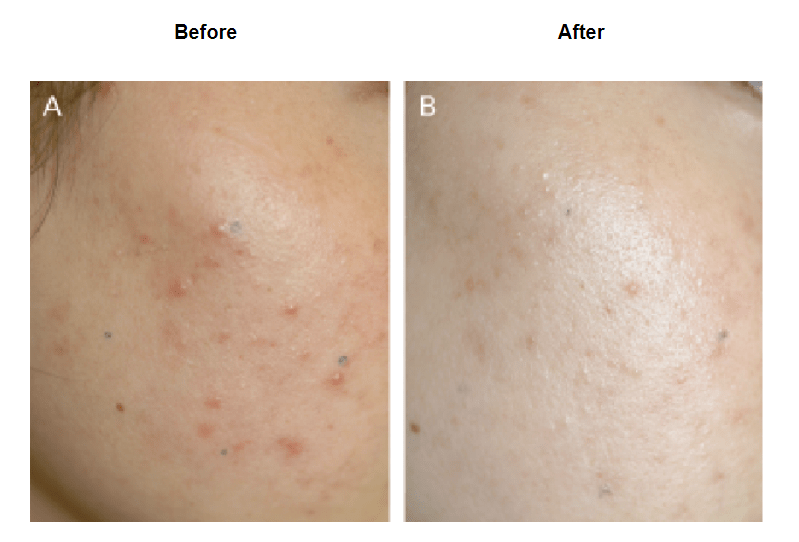
Source: Official publication for American Society for Dermatologic Surgery [et al.] 2007
Patients treated with the PDL reached a > or = 90% clearance of their inflammatory lesions after a mean of 4.1 +/- 1.39 sessions, while patients treated with IPL required a mean of 6 +/- 2.05 sessions. Patients treated with the LED required a mean of 10 +/- 3.34 sessions.
As a result, it was concluded that phototherapy is a useful therapeutic option for the treatment of moderate to severe acne.
[7] In 2012, a comparison was made between red low-level laser therapy (LLLT) (630 nm) and infrared LLLT (890 nm) for treating acne. For this purpose, one-half of the patient’s face was treated with red LLLT, and the other half was treated with infrared LLLT. After 10 weeks, the treated side at 630 nm LLLT was significantly reduced, and in the treated area at 890 nm LLLT, there was little improvement. This demonstrates the effectiveness of LLLT 630 nm in treating acne compared to infrared wavelengths. [6] In 2008, a study involving 45 participants in Egypt was conducted on the effectiveness of pulsed dye laser (PDL), intense pulsed light therapy (IPL), and LED phototherapy for the treatment of moderate to severe acne vulgaris. Participants were divided into 3 groups, and each group received appropriate treatment according to the listed options.Patients treated with the PDL reached a > or = 90% clearance of their inflammatory lesions after a mean of 4.1 +/- 1.39 sessions, while patients treated with IPL required a mean of 6 +/- 2.05 sessions. Patients treated with the LED required a mean of 10 +/- 3.34 sessions.
As a result, it was concluded that phototherapy is a useful therapeutic option for the treatment of moderate to severe acne.
[7] In 2012, a comparison was made between red low-level laser therapy (LLLT) (630 nm) and infrared LLLT (890 nm) for treating acne. For this purpose, one-half of the patient’s face was treated with red LLLT, and the other half was treated with infrared LLLT. After 10 weeks, the treated side at 630 nm LLLT was significantly reduced, and in the treated area at 890 nm LLLT, there was little improvement. This demonstrates the effectiveness of LLLT 630 nm in treating acne compared to infrared wavelengths. [8] Usually, red light is combined with blue light (which has a proven antimicrobial effect [3]) because this combination is synergistic in the treatment of acne. Below is an example of such studies.
Source: US National Library of Medicine National Institutes of Health
Light therapy is also used to treat a multitude of conditions requiring stimulation of healing, relief of pain and inflammation, and restoration of function. Which allows it to be effective for reducing post-acne scars [9].
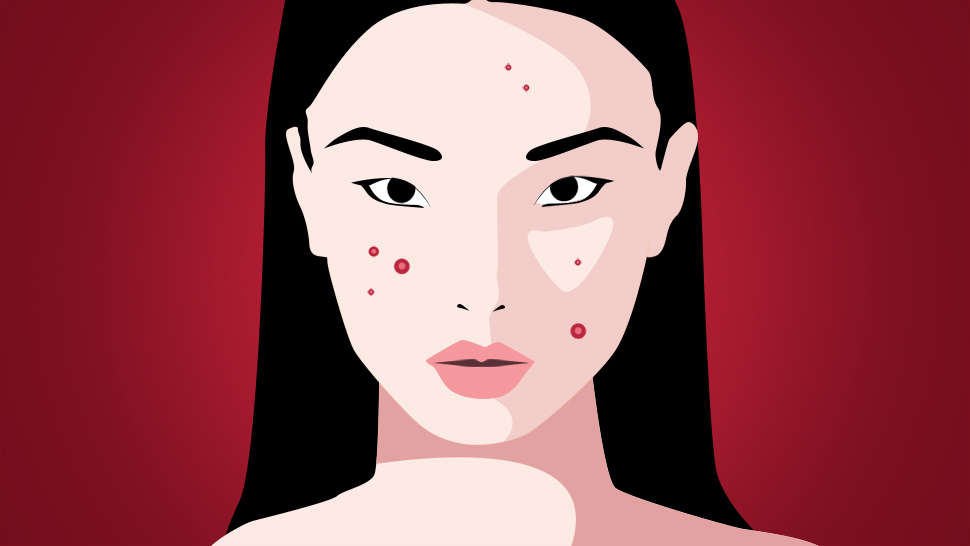
Other Effects of Red Light on the Skin
Wrinkles and density
[10] A controlled trial in 2014 determined the effectiveness of red and near-infrared light to reduce fine lines, wrinkles, skin roughness, and intracutaneous collagen density increase.According to research results, the patients’ face color, skin feeling and roughness, wrinkle condition, and collagen intensity index have improved significantly. Research proves that the use of RLT and energizing light technology (ELT) is gentle, safe, and provides pleasant skin rejuvenation.
Psoriasis
[11] In 2009, a small study that included nine patients with chronic psoriasis demonstrated the efficiency of combined LED phototherapy (830 nm in the near-infrared and 633 nm in the visible red range).These patients who were resistant to conventional treatment had impressive results. After 4 to 5 weeks of treatment, along with a follow-up period of 3 to 8 months, the recovery rates ranged from 60 to 100%.
Sensitive skin
[9] In 2020, a separate study was conducted in France on the efficacy and tolerability of phototherapy for sensitive skin.The study included 30 participants suffering from sensitive skin syndrome. Treatment was performed with exposure to the red LED twice a week for 8 weeks.
The result was a significant reduction in sensitivity syndrome in 77% of the subjects in six sessions or less.
Science and Statistics on Acne
At least 85% of people in the United States have acne between the ages of 12 and 24. A study published in the Journal of the American Academy of Dermatology, which included more than 1,000 participants aged 20 and older, found that 73.3% of them suffered from acne. The prevalence of acne was higher in women.
One study found that 96% of people with acne reported being depressed about their condition. This led to 46% having self-esteem problems because of their complexion, and 31% staying home more, refusing to participate in social activities. Acne was found to increase the risk of depression. Severe depression was found in 11% of people with acne, twice as many as people without acne.
Americans spend more than $3 billion a year on over-the-counter acne medications and an estimated $3 billion more on prescription acne medications and office visits. Only 10% of people with acne go to a dermatologist for acne. 30% of people with acne rely on over-the-counter medications to “treat” their condition [12, 13, 14].
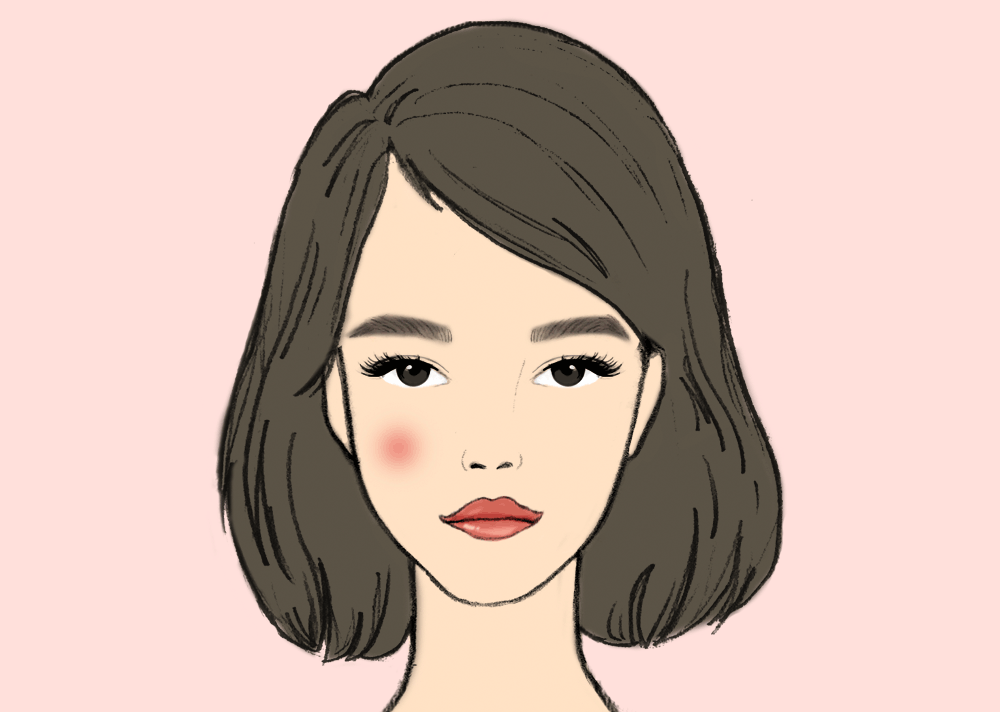
Causes of Acne
The main causes of acne are genetic predisposition and hormonal fluctuations. But there are many theories about what can affect the appearance and disappearance of acne. Some of these ideas are supported by scientific evidence, but many are not. Below is a list of the main causes and the extent to which they are scientifically supported. [15, 16, 17]
Right
- Some moisturizing creams or oils, can clog skin pores and thus aggravate acne.
- Squeezing acne or friction and pressure on the skin can make it worse. This can be caused by items such as phones, cell phones, helmets, tight collars, and backpacks.
- Some hormonal medications can cause or aggravate acne. These include anabolic agents (for building muscle) and medications such as steroids, as well as some medications for epilepsy.
Presumably
- Acne gets worse when you’re stressed.
- Eating large amounts of carbohydrates, which cause a rapid rise in blood sugar levels, may have played a role.
- The link between dairy consumption and acne is less conclusive.
- City air filled with pollutants can be harmful to the skin.
No scientific evidence
- Improper washing gives you acne or makes it worse.
- It is unclear if there is a link between smoking and acne.
The role of antioxidants, omega-3 fatty acids, zinc, vitamin A, dietary fiber, and iodine in the development of acne also remains unclear.
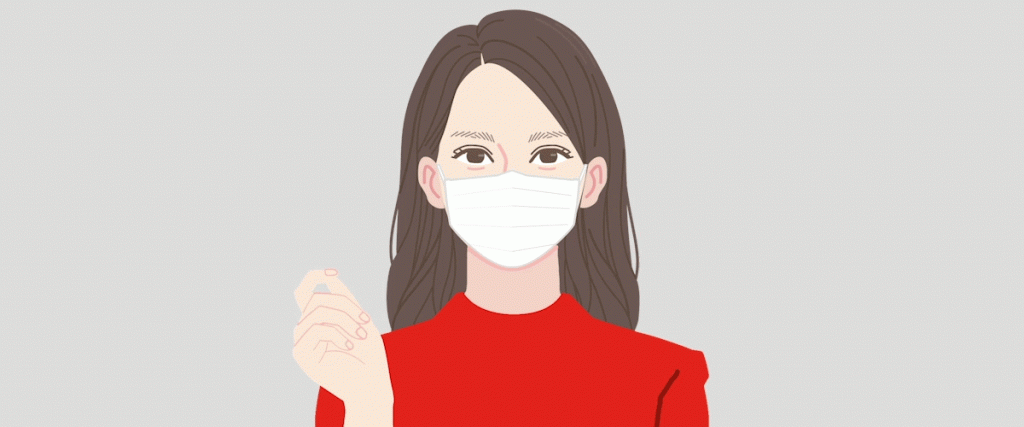
Summary
Red Light Therapy (RTL) is a rapidly evolving technology, thanks to the confirmation of numerous studies.
RTL on its own or in combination with other techniques is already actively used to treat a multitude of conditions requiring stimulation of healing, pain and inflammation relief, and restoration of function.
RTL penetrates deep into the skin where it limits the inflammatory response and reduces oxidative damage. It is therefore effective in treating acne and other inflammatory conditions such as psoriasis, rosacea, etc.
Red light therapy is a non-invasive, painless, natural, medication-free therapy, so there are no serious adverse effects from red light therapy and few contraindications. But if you do not know how your skin reacts to light therapy, it is better to do a skin sensitivity test before therapy and consult a doctor. If the red light is too intense for your body, the glare may cause some short-term effects.
The treatment requires no recovery time, and you can continue your daily activities immediately after treatment.
FAQ
👨 What does red light therapy do to the skin?
Red light therapy is actively used in the treatment of inflammatory diseases such as psoriasis, rosacea, acne, and others. Red light combined with blue light (which has a proven antimicrobial effect) increases the effectiveness of acne treatment.
🔴 Does red light therapy help with acne?
Red light therapy penetrates deeper into the skin than other light sources in the spectrum, thereby affecting the body on a cellular level. Red light therapy (RLT) limits the inflammatory response and reduces oxidative damage by reducing the number of inflammatory cytokines.
🎲 What are the causes of acne?
The main causes of acne are genetic predisposition and hormonal fluctuations. And there are also several external causes: some hormonal drugs (anabolics, steroids, and some medications for epilepsy), moisturizing creams or oils that clog pores, a lot of carbohydrates, stress, and others
⌚ How long should I treat acne with red light therapy?
All treatment periods are individual and depend on your situation. According to the results of clinical studies, noticeable changes were observed after only 8 weeks.
💡 Can red light therapy help with post-acne healing?
Light therapy is used to treat a multitude of conditions requiring stimulation of healing, relief of pain and inflammation, and restoration of function. Which allows it to be effective for reducing post-acne scars.
👩⚕️ Is red light therapy safe?
Red light therapy is a non-invasive, safe procedure. But if you have a hypersensitivity to light, you should be careful with red light therapy. Too intense light can cause some short-term effects.
👀 How does red light therapy work?
Scientists do not yet have a definitive answer as to why improvements occur, and more research is still being done to find out. But many clinical studies are showing the effects of light therapy on acne.
Sources
- Collier CN, Harper JC, Cafardi JA, Cantrell WC, Wang W, Foster KW, Elewski BE. The prevalence of acne in adults 20 years and older. J Am Acad Dermatol. 2008 Jan;58(1):56-9. doi: 10.1016/j.jaad.2007.06.045. Epub 2007 Oct 22. Erratum in: J Am Acad Dermatol. 2008 May;58(5):874. Cafardi, Jennifer A [added]. PMID: 17945383.
- Hamblin MR. Mechanisms and applications of the anti-inflammatory effects of photobiomodulation. AIMS Biophys. 2017;4(3):337-361. doi: 10.3934/biophy.2017.3.337. Epub 2017 May 19. PMID: 28748217; PMCID: PMC5523874.
- Dai T. The antimicrobial effect of blue light: What are behind? Virulence. 2017 Aug 18;8(6):649-652. doi: 10.1080/21505594.2016.1276691. Epub 2017 Jan 4. PMID: 28051916; PMCID: PMC5626200.
- Nguyen JK, Weedon J, Jakus J, Heilman E, Isseroff RR, Siegel DM, Jagdeo JR. A dose-ranging, parallel group, split-face, single-blind phase II study of light emitting diode-red light (LED-RL) for skin scarring prevention: study protocol for a randomized controlled trial. Trials. 2019 Jul 15;20(1):432. doi: 10.1186/s13063-019-3546-6.
- Na JI, Suh DH. Red light phototherapy alone is effective for acne vulgaris: randomized, single-blinded clinical trial. Dermatol Surg. 2007 Oct;33(10):1228-33; discussion 1233. doi: 10.1111/j.1524-4725.2007.33258.x. PMID: 17903156.
- Sami NA, Attia AT, Badawi AM. Phototherapy in the treatment of acne vulgaris. J Drugs Dermatol. 2008 Jul;7(7):627-32. PMID: 18664153.
- Aziz-Jalali MH, Tabaie SM, Djavid GE. Comparison of Red and Infrared Low-level Laser Therapy in the Treatment of Acne Vulgaris. Indian J Dermatol. 2012 Mar;57(2):128-30. doi: 10.4103/0019-5154.94283. PMID: 22615511; PMCID: PMC3352636.
- Lee SY, You CE, Park MY. Blue and red light combination LED phototherapy for acne vulgaris in patients with skin phototype IV. Lasers Surg Med. 2007 Feb;39(2):180-8. doi: 10.1002/lsm.20412. PMID: 17111415.
- Avci P, Gupta A, Sadasivam M, Vecchio D, Pam Z, Pam N, Hamblin MR. Low-level laser (light) therapy (LLLT) in skin: stimulating, healing, restoring. Semin Cutan Med Surg. 2013 Mar;32(1):41-52. PMID: 24049929; PMCID: PMC4126803.
- Wunsch A, Matuschka K. A controlled trial to determine the efficacy of red and near-infrared light treatment in patient satisfaction, reduction of fine lines, wrinkles, skin roughness, and intradermal collagen density increase. Photomed Laser Surg. 2014 Feb;32(2):93-100. doi: 10.1089/pho.2013.3616. Epub 2013 Nov 28. PMID: 24286286; PMCID: PMC3926176.
- Ablon G. Combination 830-nm and 633-nm light-emitting diode phototherapy shows promise in the treatment of recalcitrant psoriasis: preliminary findings. Photomed Laser Surg. 2010 Feb;28(1):141-6. doi: 10.1089/pho.2009.2484. PMID: 19764893.
- Dr. Yoram Harth, Acne statistics – update MD 2021-01-02
- American Academy of Dermatology Association, Skin conditions by the numbers
- Jaggi Rao, MD, FRCPC; Chief Editor: William D James, MD, How common is acne vulgaris in the US? Updated: Aug 28, 2020
- Cologne, Germany: Institute for Quality and Efficiency in Health Care (IQWiG); InformedHealth.org [Internet] Last Update: September 26, 2019
- Kucharska A, Szmurło A, Sińska B. Significance of diet in treated and untreated acne vulgaris. Postepy Dermatol Alergol. 2016 Apr;33(2):81-6. doi: 10.5114/ada.2016.59146. Epub 2016 May 16. PMID: 27279815; PMCID: PMC4884775.
- Marcelo Campos, MD, Acne: What you need to know – Harvard Health Blog, UPDATED: 2019
